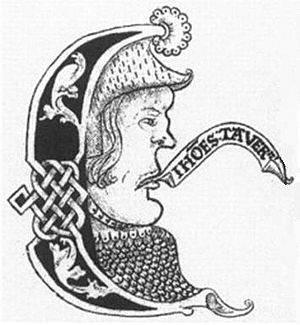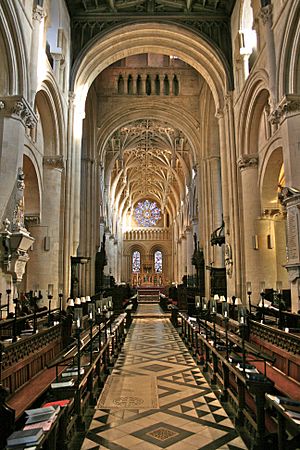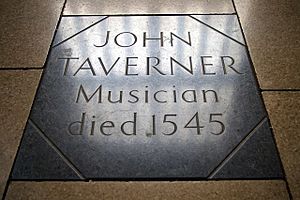John Taverner facts for kids
Quick facts for kids
John Taverner
|
|
|---|---|

A possible likeness of John Taverner in an ornamental capital E from the Forrest-Heyther partbooks, c. 1520, shown with speech scroll inscribed in Latin: Joh(ann)es Tavern(er)
|
|
| Born | c. 1490 |
| Died | 18 October 1545 (aged 54–55) |
| Era | Renaissance music |
John Taverner (around 1490 – 18 October 1545) was an important English composer and organist. He lived during the Renaissance period. Many people think he was one of the most important English composers of his time.
He is best known for his musical works like Missa Gloria tibi Trinitas and The Western Wynde Mass. His Missa Corona Spinea is also seen as a masterpiece.
Contents
John Taverner's Early Life and Career
We don't know much about John Taverner's life before 1524. He might have been born in Tattershall, Lincolnshire, in England. In 1524, he visited the Church of St Botolph in Boston as a guest singer.
Two years later, in 1526, Taverner became the first Organist and Master of the Choristers at Christ Church, Oxford. He was chosen by Cardinal Thomas Wolsey. This college was new, founded by Cardinal Wolsey in 1525. Before this, Taverner worked at the Collegiate Church of Tattershall.
In 1528, he had some minor trouble because of his connection to new religious ideas (called Lutheranism). But he was not punished much because he was "just a musician." Cardinal Wolsey lost his power in 1529. Taverner left the college in 1530.
He married a widow named Rose Parrowe, probably in 1536. She lived longer than him, until 1553. Towards the end of his life, Taverner was a town council member in Boston. He also worked as a treasurer for a local group there for about three years.
Later Life and Legacy
It seems Taverner did not have any more musical jobs after leaving Oxford. We also don't have any of his known music from after that time. This suggests he might have stopped composing.
Many people used to think that after Oxford, Taverner helped Thomas Cromwell close down monasteries. However, this idea is now thought to be very unlikely. He settled in Boston, Lincolnshire. There, he owned some land and was quite well-off.
John Taverner is buried with his wife under the belltower at Boston Parish Church. He spelled his last name "Tavernor" in his few existing signatures. The 20th-century composer, Sir John Tavener, believed he was a direct descendant of John Taverner.
John Taverner's Musical Works
Most of Taverner's music is for voices. This includes masses, Magnificats, and motets. Most of his music was likely written in the 1520s. His most famous motet is Dum Transisset Sabbatum.
Famous Masses
One of his well-known masses is based on a popular song called The Western Wynde. Other composers like John Sheppard and Christopher Tye also wrote masses using this same song. Taverner's Western Wynde mass is special because the main tune appears in almost all four voice parts at different times.
Perhaps his most celebrated work is his Missa Gloria tibi Trinitas. Taverner probably wrote this while he was at Christ Church, Oxford. His masses often have four sections (Gloria, Credo, Sanctus-Benedictus, and Agnus Dei) that are about the same length. He did this by repeating the main musical ideas the same number of times in each section. For example, in the Western Wynde mass, the tune is repeated nine times in each section.
Composition Techniques
Many of Taverner's other masses use a technique called cantus firmus. This is where a simple plainchant melody with long notes is placed in one of the middle voice parts, often the tenor. Examples of masses using this technique include Corona Spinea and Gloria Tibi Trinitas.
Another technique is seen in his mass Mater Christi. This mass uses musical ideas from his motet of the same name. This type of mass is called a "derived" or "parody" mass.
The In Nomine Style
The Missa Gloria tibi Trinitas also led to a new style of instrumental music called an In nomine. This mass has six voice parts. Some parts are for fewer voices, probably for solo singers, to show off their skills.
The section with the words "in nomine..." in the Benedictus part of the mass has four voices. The plainchant melody is in the alto voice. This specific part of the mass became very popular as an instrumental piece for viol consort (a group of viol instruments). Other composers then started writing instrumental pieces based on this idea. These pieces were given the name In nomine.
John Taverner's life was also the subject of an opera called Taverner, written by Peter Maxwell Davies.
List of John Taverner's Works
Masses
- Missa Gloria tibi Trinitas (6 voices)
* This mass was likely written for Trinity Sunday. The original music books for this work have small pictures of Taverner in the first letters of the music.
- Missa Corona Spinea (6 voices)
- Missa O Michael (6 voices)
- Missa Sancti Wilhelmi (5 voices)
* Sometimes called Small Devotion.
- Missa Mater Christi (5 voices)
- The Mean Mass (5 voices)
- The Plainsong Mass (4 voices)
- The Western Wynde Mass (4 voices)
Mass Fragments
- Christeleison (3 voices)
- Kyrie Le Roy (4 voices)
Votive Antiphons
- Ave Dei Patris filia (5 voices)
- Gaude plurimum (5 voices)
- O splendor gloriae (5 voices)
* This piece might have been written with Christopher Tye.
- O Wilhelme, pastor bone (written to honor Cardinal Wolsey)
Office Music
- Alleluya. Veni electa (4 voices)
- Alleluya (4 voices)
- Te Deum (5 voices)
Motets
- Audivi vocem de caelo (4 voices)
- Ave Maria (5 voices)
- Dum transisset sabbatum (I) (5 voices, also a 4 voice version)
- Dum transisset sabbatum (II) (4 voices)
- Ecce carissimi
- Ex ejus tumba – Sospitati dedit aegro
- Fac nobis secundum hoc nomen (5 voices)
- Fecundata sine viro (3 voices)
- Hodie nobis caelorum rex
- In pace in idipsum (4 voices)
- Jesu spes poenitentibus (3 voices)
- Magnificat (4 voices)
- Magnificat (5 voices)
- Magnificat (6 voices)
- Mater Christi (5 voices)
- O Christe Jesu pastor bone (5 voices)
- Prudens virgo (3 voices)
- Sancte deus (5 voices)
- Sub tuum presidium (5 voices)
- Tam peccatum (3 voices)
- Traditur militibus (3 voices)
- Virgo pura (3 voices)
Other Works
- In trouble and adversity (for 4 voices, based on his instrumental piece In Nomine).
Secular Works
- In women (2 voices)
- Quemadmodum (possibly for viols or recorders)
* This piece is now thought to have been a motet, using words from Psalm 42. A choral version of this work was published in 2010.
See also
 In Spanish: John Taverner para niños
In Spanish: John Taverner para niños



